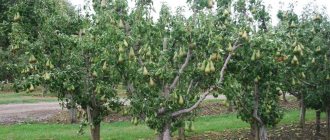Planting roses in open ground is not an easy task, especially for a novice gardener. In this article we will tell you in detail how to do it correctly in order to grow a beautiful rose garden yourself.
The most suitable time for autumn planting roses is from mid-September to early October. Plants planted during this period manage to take root well before the onset of frost and quickly begin to grow in the spring. This primarily applies to regions where the winter is quite mild. In autumn, the earth is well warmed up, there is enough rainfall, so the seedlings develop better than when planting roses in the spring.
When is it better to plant roses - in spring or autumn?
Roses are planted in spring and autumn. But when exactly it is best to do this is difficult to answer unequivocally, since the opinions of experienced flower growers are divided. There is a large group of supporters of autumn rose planting.
They are confident that autumn is the ideal period for this operation. Both the air temperature and relative humidity, as well as the condition of the soil, are favorable. By planting a seedling on warm autumn days, you can get its first flowering in the spring.
Planting roses in the fall is most often done in the southern regions of the country, where autumn is quite warm and frost is still a long way off. The optimal time period is between September 25 and October 5.
There is an opinion that it is better to plant seedlings with an open root system in the garden in the autumn, but in fact this operation can be carried out:
- in spring;
- in the summer;
- in the fall.
The color of the living root when cut should be white. If it is brownish, this indicates that the area is dead. It must be cut until a white color appears.
Summer planting is also not prohibited. This method is suitable for container roses with well-formed roots. They cannot be damaged. When planting in summer, you need to take care to protect the plants from the sun's rays and water them quite often.
Advantages of planting roses in autumn
Supporters of autumn planting will highlight the following advantages of this time of year:
- In the spring, such seedlings immediately begin to grow rapidly and are superior in this indicator to roses that were planted in the spring.
- In autumn there is a lot of precipitation and favorable weather with high air humidity sets in. Evaporation from the leaves is minimal and the seedlings take root in the soil faster. Rain naturally moistens the soil and there is no need to control its moisture.
- After hot summer days, the soil has not cooled down; its temperature is still in a favorable range for quite a long time for better rooting of planting material.
- If the date for planting roses was chosen correctly, then frosts that come late in the fall are no longer dangerous for young plants.
- In autumn, the buyer is offered a large number of high-quality seedlings and has plenty to choose from. And in the spring they will most likely sell you last year’s seedling, which they did not buy in the fall.
- In the spring, summer residents are very busy with various works, and in the fall they can always choose the time for this work.
Disadvantages of autumn planting
You just read about the benefits of fall planting and they are impressive. However, planting at this time has some disadvantages:
- If you don’t guess when to plant roses in the fall and plant them earlier than the recommended time, the seedling will still grow and acquire green shoots and leaves. It will enter winter weakened and is unlikely to survive the winter safely.
- If planting is done later than the recommended time, for example, in early November, then before the onset of cold days the young plant will not be able to take root properly and will inevitably freeze in the winter.
- If roses are not properly covered for the winter, serious problems arise for their future life. Roses can freeze from insufficient shelter or die from fungi if they are over-covered.
Advice! If you decide to plant roses in the fall, you need to carefully monitor weather changes and do all the work in a timely manner.
How to build a winter shelter
For the winter, the young plant must be insulated
Young plants should definitely be covered. To do this, you can use the following devices:
- frame canopy - for this you need to take burlap and agrofibre and stretch it over the posts;
- hut - it can be made from pine or spruce branches.
Small bushes should be covered with dry leaves and old things. You can also find special covers in flower shops that are designed to cover crops. The convenience of their use lies in the fact that with the arrival of spring, the structure can be easily removed and put back in place.
Planting a rose in the fall is much better than in the spring. Thanks to this, the crop will be able to take root and harden during the winter. This will make the bush more resistant to diseases and parasites. To successfully grow a beautiful flowering plant, it needs to be provided with complete and high-quality care.
Does the variety of rose affect the planting date?
Planting roses in open ground in the fall must be done according to the rules, observing the deadlines. To carry out this work correctly, as well as all care activities, you must have the appropriate knowledge.
It is known that there are quite a lot of types of roses and they all have characteristic differences.
Types of roses for growing
Planting and caring for roses may differ depending on the type. Below is a description of the main types, taking into account their characteristics.
Park roses
They are quite unpretentious, do not place great demands on soil and care, and withstand frost and heat well. They enter the flowering phase in spring earlier than other species. Flowering is extended and lasts almost a month.
climbing roses
These flowers have elongated shoots and grow around a support. They are used to decorate gazebos, fences or columns. Roses of this type are divided into 3 groups:
- curly, up to 15 meters long;
- climbing – up to 5 meters;
- semi-climbing - up to 3 meters.
Planting can be done in spring and autumn. Before the planting procedure, the roots and branches of the seedlings are shortened to 35 cm.
Such roses cannot grow without support. The rose is planted with an inclination towards the support, and the roots are oriented so that they are directed in the opposite direction from it. They should be covered in winter.
Important! When planting, the seedling is buried so that the grafting site is at a depth of 5 cm, and for standard roses at a depth of 10 cm.
Ground cover roses
Representatives of this species are very different and bloom profusely until autumn. They are usually planted on a hill and with a slope. They are unpretentious, but after planting they need to be watered abundantly.
This species does not get along well with weeds.
Tea and Floribunda roses
These species are best planted in spring. Curly shoots of the tea variety will need support.
Planting holes for these varieties are made: 50x50 cm with a planting interval of about 50 cm.
Hybrid tea roses
Flowers with an excellent scent and different bud colors. May bloom again throughout the season. However, their high demands on growing conditions and low resistance to hot weather, severe frosts and common diseases are noted.
Planted only in spring in May, when warm weather sets in.
Planting standard roses
Standard roses look like small trees, so the hole for planting them should be larger and the distance between seedlings should be at least one meter. Another important feature of planting is that the seedling must be planted at an angle of forty degrees. This will make it possible to bend the plant to the soil for the winter.
In order to stimulate bud growth, the crown of the tree must be laid aside with moss and covered for about two weeks. After removing the cover and pruning, you need to form a crown shape.
AllaAuthor of the article
Did you like the article?
Share with your friends:
The necessary conditions
It is very important to provide the seedlings with the required conditions. Only in this option will the plants grow and develop well, delighting their owner and his guests with magnificent flowering.
Let's see what conditions roses need for normal growth.
- One of the most significant requirements is to provide plants with sufficient nutritional area when planting. That is, it is important to follow the recommended planting pattern.
- Choosing an area for planting roses. It’s good if the place is sufficiently lit, but protected from midday rays - they can burn the leaves.
- Experienced flower growers advise planting flowers in the western or southeastern outskirts of the garden. Then the flower garden will fully receive the morning rays, and in the middle of the day a shadow will fall on the roses.
- It is better to plant on a slope, in ridges raised by 30 cm. Then the roses will withstand the most severe frosts, and in the spring they will not get wet from melt water.
- When planting, it is a good idea to take into account the acidity and moisture of the soil. Slightly acidic soils with a pH level of 6-6.5 units are considered optimal. And high soil moisture will definitely have a negative impact on roses.
- Autumn planting should be done in warm and dry weather. Air humidity should be 75-85%.
- Use seedlings with excellent roots and 3-5 shoots. When purchasing a seedling, scratch the root with your fingernail. A healthy root will be firm and white.
Attention! Planting roses in open ground in the fall must be completed a month before the arrival of the first frost. This time is enough for the young seedling to take root and prepare it for winter.
Conditions for further care of a young bush
Planting hydrangea in spring in open ground
To grow a strong crop, it needs to be provided with adequate care. At the same time, you need to understand that all useful substances have already been added to the soil at the stage of planting. The bush was also pruned and treated for fungi.
Frequent watering in the fall is also not required. In dry and warm weather, the substrate can be moistened. This should be done at intervals of 3-5 days. To do this, you will need 5-7 liters of water per bush.
When carrying out planting work, special attention should be paid to preparing the rose for winter. Even if frost resistance allows the crop to survive the cold, it is much better to play it safe and insulate the root system. In this case, it is recommended to clear the tree trunk circle of plant debris.
Dates for planting roses in autumn
It is difficult to answer the question of what period of time should be considered optimal for planting rose seedlings. Flower growers themselves decide when to plant these seedlings. If all requirements are met during preparation and planting, then the roses will take root well and develop normally, regardless of the planting season.
When planning to plant these flowers, you need to take into account the weather conditions of the growing region or be guided by the lunar calendar.
As usual, roses begin to be planted in September and are completed in the last days of October. Such a long period is explained by regional climatic features. In warm areas, October is used for planting, and in cooler areas, you need to hurry and do the work in September.
The best period is when the daytime temperature is between +10 and +15 degrees, and at night the thermometer shows the temperature in the range of 5-10 degrees above zero. This temperature is sufficient for root growth and too low for the awakening of vegetative buds.
According to the lunar calendar 2020
In order to plant and care for a rose at the right time, taking into account the lunar cycles, you need to follow these recommendations:
- New moon. It is forbidden to carry out any work in the flower garden.
- Crescent. You can only water and spray the rose bushes.
- Full moon. During this period, roses are not planted, since they will begin to build up the vegetative part and will bloom very poorly.
- Crescent. It is only allowed to water and spray the bushes.
- Waning moon. In this lunar cycle, it is recommended to cut flowers to form bouquets and cut out faded buds.
And the following autumn days in 2020 will be favorable for carrying out work related to planting roses in a permanent place in the garden:
- September—9-11, 16-21, 24-25
- October — 3-8, 13-15
Depending on the region
We already wrote above that the region of cultivation greatly influences the determination of when to plant roses in the fall. In some areas it is better to plant it in September, and in other places the month of planting is October.
- In the central zone and in the Moscow region, seedlings of these flowers can be planted both at the beginning of the first month of autumn and at the end of this month.
- In the Urals and Siberia, autumn planting of roses is not recommended, but in warm autumn you can take a chance and plant roses at the junction of August and September. In this case, the grafting is buried into the soil not by 5, but by 7 cm. If young plants have another 30 days before the onset of frost, they will take root safely and overwinter.
- In the south of Russia, rose seedlings are planted in October. In those areas, frosts come later than in more northern regions and the seedling will have enough time to take root.
Choosing a site for growing roses
The seedling will take root well and will grow actively only in the right area. In this case, it is necessary to take into account some requirements. The fact is that a rose is a rather whimsical plant for which it is necessary to create suitable conditions.
Rose loves warmth and sunlight. Therefore, only well-lit places are chosen for growing “flower queens”. On the north side, the flower garden can be covered by buildings, the main thing is that the south side is completely open. Bushes should not be blown by winds from all sides. In addition, the rose does not grow well in shady places. For this reason, the plant is not planted near trees and lush shrubs.
Attention! Rose bushes will not grow well in wet clay soil.
The groundwater level in the area with roses should not be too high. Stagnant moisture can cause rotting of the root system. In such conditions, roses will simply die. What soil is suitable for growing roses?
There are 3 main criteria:
- loose fertile soil;
- soil acidity level – slightly acidic;
- a sufficient amount of mineral and organic fertilizers.
To plant seedlings, you need to prepare the area in advance. To do this, it is carefully dug up. At this stage, you can apply mineral fertilizers. The amount of nutrients is determined according to the instructions. A month before planting the bush, you need to fertilize the soil with compost or humus.
How to store seedlings in the fall before planting
If you acquired seedlings ahead of time and do not know what to do with them before planting in September, then we will tell you how to preserve seedlings for a while.
Cold storage
This is a very popular method, since such a device is available in any home. Seedlings with an open root system are wrapped in a paper towel, after moistening it with water, then placed in a synthetic bag and placed in the vegetable compartment, where the temperature is maintained from 0 to 3°C.
The same seedlings located in containers should also be sent to the refrigerator. Before this, they are wrapped in synthetic film.
Cellar storage
Rose seedlings are preserved quite well for up to 60 days in the cellar, at a temperature of 0 to 3°C. To do this, they are placed in a bucket and sprinkled with moistened sand so as to cover the root collar.
Storing a flowering plant
If you purchased a container with a blooming rose, then you can put it at home, but not for more than 3 weeks. During this period of time, the rose will have time to bloom, partially using the nutrition from the container.
After planting, it will quickly recover and develop.
Selection of seedlings
When choosing good seedlings, you should pay attention not only to their condition. You should definitely inquire about the frost resistance of the variety and the zone in which the plant will feel normal.
With open root system
It is these seedlings that most often appear on sale in spring and autumn. They look like seedlings with the root system wrapped in a small bag; sometimes burlap or packaging film is used instead of a bag.
When choosing a healthy specimen with sufficient growth potential, pay attention to the following factors:
- the presence of three or more main shoots, in extreme cases – two, but strong and quite thick;
- there should be no dark or whitish spots or other signs of fungal infections on the leaves and stems;
- developed root system of normal volume;
- root collar with a diameter of 8 to 10 cm.
To make sure the seedling is healthy, you need to carefully scratch the root with your fingernail. This is done so as not to injure the delicate area. If the root is rotten, soft from rot, or crumbles into dust, such a specimen is not suitable.
Roses with bare rhizomes should be purchased just before planting, since storage in improper conditions quickly leads to damage to the planting material. Inside the package there may be peat, sawdust or brown paper for transportation. It is these materials that ensure normal transportation and prevent damage to the lower part of the bush.
With closed root system
So-called container seedlings are sold all year round. Most often, containers are containers larger than 5 liters in volume. The earthen ball inside the container should not be loose: this means that the plant was planted shortly before sale. The soil should easily move away in a continuous layer from the walls of the container.
Roses with a closed root system provide a number of advantages when transplanted:
- they can be planted not only in autumn, but also at any other time of the year;
- They can be planted not immediately after purchase, but also after a long time;
- During handling, even the thin tendrils of the roots are not damaged, so the plant is practically not under stress.
Container seedlings can be transported not only in soil, but also in moss or any other organic substrate, secured with jute mesh or thick cardboard. In this form, they are not only transported over any distance, but can also remain for a long time without the risk of injury or drying out of the root shoots.
Before planting, this organic packaging should not be removed: it will dissolve in the soil over time without interfering with the bush’s growth.
Rules for planting roses in autumn
When planting roses in the fall, you need to know some of the nuances of this operation in order to do everything correctly.
Selection and preparation of seedlings
When choosing and preparing rose seedlings for planting, adhere to the following rules:
- Purchase flower planting material from specialized retail outlets or from suppliers who have good reviews.
- The roots must be developed and grow in all directions. It is unacceptable for them to have stains and rotten areas.
- Seedlings should have an intense green color with gloss, sharp thorns, 3 or more developed shoots.
- If the seedling is placed in a container with soil, then check how the soil lags behind the pot. This determines the duration of the seedling’s stay in the flowerpot. If the seedling has leaves, they should be dark green and without spots.
- Bare-rooted seedlings must be prepared for planting. If they are in a pot, do nothing until planting.
If the purchase of seedlings is made shortly before planting, then it is better to pay attention to seedlings with bare roots. Such planting material is easy to see and notice all the shortcomings of the product.
Bare-rooted seedlings are prepared as follows:
- put the roots in a container with water for a day;
- remove all leaves;
- shorten all shoots of the seedling to 30 cm;
- the roots are trimmed so that their length is 25 cm;
- rotten sections of roots are cut off;
- remove the buds located below the graft.
For preventive purposes, seedlings are treated against a number of diseases with a 3% solution of iron sulfate, and then the roots are dipped in a clay mixture with mullein.
Choosing a landing site
Roses need a sunny area, protected from cold winds. Therefore, they usually choose an area that is well lit by the sun, but at lunchtime a light shadow falls on the rose garden.
Those people who plant a flower garden near tall trees that cast a constant shadow on the flower garden do the wrong thing.
It is not a good idea to place the rose garden in low areas where water will stand for a long time in the spring or after heavy rains. Areas with high groundwater levels are also not suitable. Rose does not tolerate high soil moisture. This causes its roots to rot.
- A shrub planted in the shade will begin to reach for the light, will become sick, and will not bloom profusely.
- Plants placed on the south side will always experience a moisture deficit due to excess evaporation, and the flowering period will become very short.
Selection of soil and fertilizer
Roses are quite demanding on soil fertility. In addition, the soil must be loose with excellent air and water conditions.
The area for planting roses is prepared 17 days before the planting procedure.
The area for planting roses in the fall should be dug to a depth of 40 cm, and on acidic soils add lime or dolomite flour. On heavy soils, add peat or sand.
When preparing substrate mixtures, do not use soil on which cherry or apricot, as well as hawthorn and other representatives of the Rosaceae family, were grown.
Preparing planting holes
Next you need to move on to preparing the planting holes. Their depth and diameter should be about 50 cm.
The interval between planted seedlings depends on the type of roses. Here are the intervals followed when planting for different types of roses:
- polyanthus, hybrid tea and floribunda roses – 30-60 cm;
- park roses - 75-90 cm;
- climbing and standard - up to 1 meter.
Planting methods
When planting roses in open ground in the fall, two options are usually followed. The first option is called dry. With this option, a slight mound is formed at the bottom of the pit. A seedling is placed on it, its roots are straightened and covered with soil. Next, the soil is lightly compacted and watered.
There is another 2 method of planting, called wet. With it, a solution of sodium humate is made and poured into the planting hole. The remaining landing steps differ little from the dry method.
Both options have their advantages and are therefore widely used in horticultural practice.
Important! On heavy clay soils, brick fragments, expanded clay or large pebbles are poured into the bottom of the planting hole as drainage.
Planting roses with an open root system
Late planting of roses in October - features
Common landing mistakes
Unfortunately, flower growers in their daily practice make typical mistakes when planting roses in open ground in the fall:
- Many people recommend planting rose seedlings in a peat substrate. This recommendation should not be followed, since in such a substrate the roots will rot and the plant will die. The best option is to plant in loamy, well-fertilized soil.
- Some summer residents plant carelessly, without straightening the roots. As a result, the roots end up bent upward. In this case, the plant suffers for a long time and grows poorly.
- Often after planting, the root collar is excessively buried in the ground. If the depth exceeds 5 cm, then the plant will be depressed, begin to wither and ultimately most likely die.
After planting, roses are watered abundantly. Then, when the soil settles, add soil to the seedling and compact it.
Planting roses from cuttings
We already wrote above that different types of roses have their own characteristics that should be taken into account when planting. The differences lie in the size of the planting hole and the spacing between the plants placed.
But there is no difference in the timing of autumn planting of roses for those species that can generally be planted at this time.
Many gardeners, when choosing planting material, prefer cuttings. Moreover, for planting they use rooted cuttings that they grew themselves.
And no wonder, because in order to root cuttings you need to do only 5 simple steps:
- At the beginning of summer, in the shady part of the garden, we dig a trench 15 cm deep. It should have 1 vertical side. Pour a two-centimeter layer of sand onto the bottom of the depression.
- From a rose bush to be propagated, we select an even and mature shoot of the current year, 0.8 cm thick.
- Below the bud we cut a stalk 20 cm long. From its lower part we cut off the leaves and thorns. You can leave 2 leaves at the top of the cutting.
- We stick the cuttings 15 cm apart from each other with their bases into the sand, lightly compacting it. We fill the trench with soil so that the cuttings are 2 thirds buried. We compact the soil, trying not to touch the cuttings.
- During the summer we water, trying to maintain constant soil moisture. In the fall, the cuttings will have roots and can be planted in the garden instead of seedlings.
Planting bush roses. Care
Planting bush roses follows the general rules, but there are some peculiarities in care. Shrub roses prefer foliar fertilization. The roots of such roses are located close to the surface and in order to prevent weeds from taking nutrients from them, weeds must be regularly removed. Shrub roses need pruning. It is necessary to remove weak, damaged shoots that interfere with the proper growth of the bush.
Care after landing
Now you know when to plant roses in the fall and how to do it correctly. The list of maintenance work is small. As usual, young bushes are not watered before the onset of cold weather, since precipitation usually occurs at this time, providing sufficient soil moisture. Well, if there is no rain, then the bushes should be watered.
The rose also does not need fertilizing before winter. The amount of fertilizer that was applied earlier will be enough for them until spring.
After planting roses in the fall, do not use nitrogen fertilizers. Nitrogen will cause the vegetative part of the plant to grow and these shoots will freeze in winter.
Do roses need to be watered after planting?
Many gardeners, especially beginners, are often interested in whether it is necessary to water rose seedlings immediately after planting. The answer is yes. Watering should be plentiful - water, seeping into the soil, will displace air from the voids, the earth will settle and the roots will be in a dense layer of soil.
When the earth settles after watering, you need to fill the sagging surface with the earth that remains after digging the hole. Finally, compact the soil on top a little.
Do I need to prune roses after planting?
After planting roses in open ground in the fall, it is necessary to perform pruning. At the same time, 2 viable buds must be left on each seedling. This operation is usually postponed until next spring.
The sections are treated with garden varnish or other special store-bought product. If this operation is performed in the fall, the young shoots that appear will not have time to ripen and will freeze out during the winter.
Further care should be aimed at preparing the bushes for winter. With the arrival of night frosts, you need to start covering young plants with insulating material. Alternatively, it is proposed to do the following:
- cover the bushes with pine branches;
- Place sawdust and fallen leaves on top of the branches in a 15 cm layer;
- install metal or plastic arches up to 0.5 meters in height;
- Stretch agrofibre over the arcs;
- until the ambient temperature reaches minus 11 degrees, it is necessary to leave an interval for ventilation between the covering material and the arcs;
- when the frosts become stronger, the gaps are sealed and ventilation is stopped.
How to care for roses after planting in the fall
In autumn, it is important not only to plant rose seedlings correctly, but also to properly care for them. This is necessary so that they take root safely and take root.
Basic elements of caring for roses after autumn planting in open ground:
- Mulching. It will help prevent the formation of an earthen crust after watering, which prevents air circulation in the soil. In addition, during hot periods, mulch protects the root system from overheating, and during cold periods, from hypothermia. Compost, humus, peat can be used as mulch, and the optimal thickness is 7-10 centimeters.
- Loosening. If for some reason you have not mulched the young plantings, then before winter shelter and the onset of the first frost, you need to loosen the top layer of soil after each watering or rain to prevent crust formation.
- Shelter for the winter. Frost protection is especially important in regions with cold winters. It is difficult to name the exact timing of the procedure; plants need to be covered at the moment when stable frosts set in (about -5, -7 degrees). For example, you can cover it with spruce branches or agrofibre.
Of course, to do everything correctly, you need to work a little and show attentiveness and hard work. However, the beautiful blooming of truly royal flowers will make you forget about all the difficulties and costs!
Advice from experienced flower growers
People who have been working with roses for a long time and have accumulated sufficient experience recommend following the following rules when planting roses:
- Do not plant roses in peaty soils, as these types of soil retain too much moisture. This can cause root rot.
- Plant flowers in loamy soil. Such soil has good aeration, enough useful elements and maintains a good water regime.
- When planting, bury the roots to the recommended depth and spread them out. This will promote good rooting and overwintering.
- Do not water with cold water.
Planting roses in open ground in the fall should follow certain rules and take into account the characteristics of the plant. To achieve success, it is worth taking into account the experience of venerable flower growers and following our recommendations outlined in this article.
With care and patience, you end up with a delightful area with mesmerizing flowers on it.
What to do if the gardener is late planting roses
If it was not possible to plant roses on time, the work must be postponed until spring. Before this, all plants are planted in a greenhouse. If it is not available on the site, it is permissible to make a depression 40-50 cm in size, place a bush in it and sprinkle it with peat. Cover the top with spruce branches to protect the crop from frost.
Planting hydrangea in spring in open ground
If you have a warm basement, the bushes can be placed in it. To do this, it is recommended to distribute them into boxes filled with clay and sand.
Important! Untimely planting will provoke the death of an unrooted crop. It is better to postpone the work until spring.
Should the root collar of roses be buried when planting?
The root collar is very vulnerable in winter. It can get wet during prolonged thaws and freeze slightly in winters with little snow. On heavy clay soils with regular stagnation of moisture, the root collar is placed above ground level, protecting it from getting wet, and on loose permeable soils, on the contrary, it is often buried a little so that it does not freeze in winter.
After planting, fill the hole and immediately water thoroughly to form a small puddle in the root circle. Water, going into the ground, will remove air voids in it.
After the first puddle is completely absorbed, watering must be repeated (perform similar waterings periodically until the onset of stable cold weather).
At the end of 2 waterings, perform hilling, raking the surrounding soil towards the bush. There should be no holes left in the tree trunk circle, so that there is no stagnation of moisture around the root collar in the future.
What month is best to plant?
Autumn weather changes quickly, so it is important to plant roses before the end of the favorable period. The optimal time for planting bushes with an open root system is September and early October. It is impossible to name the exact days, it all depends on the weather. It is important to complete planting at least 3 weeks before the arrival of autumn frosts so that the rose seedlings have time to adapt.
When choosing a planting time, take into account temperature conditions. It is advisable to plant roses on days when the daytime temperature is +12-15 °C, and the night temperature does not fall below +5 °C. Under such conditions, the roots will take root, but the buds will not wake up until spring.
The optimal timing for autumn planting of roses varies in different climatic regions:
- in the central zone - the second half of September, the first days of October;
- in the southern regions of Russia - during October;
- in Siberia, in the Urals - all September.
Advantages of planting in autumn
It is difficult to say unequivocally what is the best time for planting roses. Some gardeners believe that it is better to plant them in the spring, while others are more inclined towards autumn planting.
Note: Since we are considering planting roses in open ground in the fall, we will consider the merits of this procedure.
It should be immediately clarified that bushes planted in spring require more careful care. They must be shaded from the scorching sun, and watered regularly in the summer.
The main advantages of autumn planting are:
- By the time cold weather sets in, the root system has time to fully strengthen. Due to this, in the spring the bush is already considered adapted and begins to grow actively.
- Roses planted in autumn begin to bloom earlier, since their underground and above-ground parts develop evenly.
- Bushes require less care. Of course, young seedlings will have to be properly prepared for winter, but in general, care does not pose any serious difficulties.
Figure 2. Bushes planted in autumn bloom much earlier.
It is important to take into account the varietal characteristics of the crops. Some roses, particularly climbing roses, are simply not intended for autumn planting, so choose the type of plant carefully (Figure 2).
Preparing seedlings
If you purchased a seedling with an open root system, soak it in water a day before planting. Then remove the leaves, using a sharp pruner, cut out all the damaged roots, cut off the slightly rotten ones to a healthy place, shorten the above-ground part to a length of 30 cm. Also remove the buds that are located below the grafting site, since wild shoots will grow from them.
Then spray the seedling with 3% iron sulfate, dip the roots into clay mixed with mullein in a 2:1 ratio. This will protect the rose from diseases and pests.
Carefully inspect the rose seedling. It must have at least three well-developed, intact shoots. Saplings with an open root system should have branched roots and many small roots.
Aftercare and preparation for winter
One of the main advantages of autumn planting is the absence of complex care in the future. Explore its features:
- Water the rose if autumn is dry.
- Do not apply fertilizer. The nutrition added during soil preparation will last until spring.
- After planting, build a frame around the rose from curved metal rods that can withstand the weight of the insulation. Cover the structure with plastic film, geotextile, lutrasil, spunbond or agrofibre, burlap or an old blanket. If you use polyethylene, leave holes in the greenhouse until frost sets in.
- For better protection in winter, cover the rose with snow.











